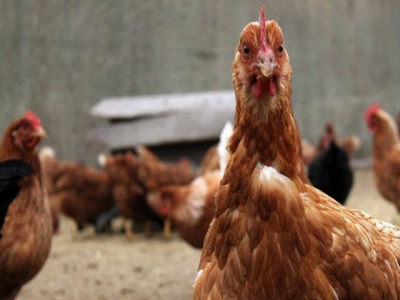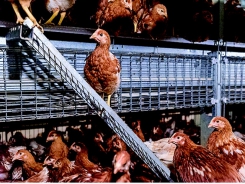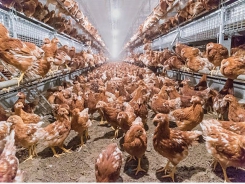How free-range access impacts poultry health, welfare

Does free-range access really offer birds a better lifestyle? A recent report dove into the research surrounding the issue.
Photo by Andrea Gantz
After years of agricultural progress placed the bird inside a cage or barn in the name of efficiency and food safety, the chicken is heading back to the barn yard. However, is this the best move for the animal?
In recent years, retailers and consumers demonstrated increased interested in free-range or pasture-raised poultry products. The perception is that an animal raised outside of a barn or a cage leads a better life than one raised inside.
Some egg producers are already raising pasture-raised laying hens in order to produce value-added specialty eggs. That same trend may arrive to the broiler world, too, as more retailers sign onto animal activist-lead welfare pledges. One such pledge, the Global Animal Partnership, calls for a progressive system that eventually requires all chickens to be pasture raised.
To gauge how pasturing truly affects animal welfare, the Council for Agricultural Science and Technology (CAST) recently issued a report – titled “Impact of Free-Range Poultry Production Systems on Animal Health, Human Health, Productivity, Environment, Food Safety, and Animal Welfare Issues” – examining the collected research on the complex topic. In a July 2018 online presentation Dr. Anthony Pescatore, an extension professor in the Department of Animal and Food Sciences at the University of Kentucky and one of the researchers for the report, spoke about the in-depth look at free-range access and whether or not it has an impact on animal welfare.
Understanding what animal welfare means
Some of the growth in poultry rearing efficiency can be attributed to improvements in genetics and nutrition, but bringing birds inside was a critical step as well. Pescatore said farmers were able to control the environment, and better protect the animal.
However, the gulf between farming and the general public is wide and growing. Consumers want to better understand where their food comes from and they want what’s best for birds. Many consumers now feel free-range and outdoor access is associated with better animal welfare.
In this environment, Pescatore said understanding animal welfare is critical for producers. But research suggests welfare is complicated, controversial and based on conflicting information. To better quantify welfare, the researchers examined health, physiology, expression of natural behaviors and psychology.
Health
Pescatore said free-range production typically means more mortality. The average mortality of free-range birds is about 10 percent, but it ranges as high as 70 percent and as low as 0 percent.
Furthermore, laying hens with outdoor access had lower plumage damage and a reduced incidence of footpad dermatitis compared to caged hens. Free-range hens do have better bone integrity; however, that improved integrity is not enough to prevent fractures or keel-bone deformities, Pescatore said.
“As the birds have more access to move, they have more chance of flying, running into things and flying higher,” he said.
Physiological measures
Physiological factors studied include changes in heart rate, body temperature, respiratory rate, adrenal secretions and/or depressed immune function, which are classic measures of stress. Other measures of stress include increased corticosterone levels in blood, circulating quantity of white blood cells and the ratio of specific cells, particularly the heterophil to lymphocyte (H/L) ratio.
Pescatore said higher H/L ratios are found in hens raised in cages compared to free range. However, results do depend on different variables, including how the samples were taken and the handling of the birds.
Birds' needs and wants
Stress, Pescatore said, is usually brought onto birds through either aversion or deprivation.
Aversion is stress resulting from conditions that an animal wants to avoid. Deprivation is stress resulting when an animal is unable to complete a behavior that it wants to perform.
Preference tests have been utilized to study stress in birds. These tests are used in controlled situations to determine needs and wants; however, the findings are not consistently transferred to the farm, Pescatore said. When results from the preference tests were applied to on-farm settings, there were no consistent results that showed a positive result for the birds.
Fear in birds
Pescatore said the level of fear in birds is studied using a tonic immobility test. This is when a bird is placed on its back and researchers measure the time it takes for the bird to flip itself over. The longer it takes for the bird to flip over, the more fearful the bird is.
Hens that spent most of the time outside displayed a decrease in fearfulness as indicated by reduced time of tonic immobility, he said. Hens that spent less time outside indicated higher levels of fearfulness during the tonic immobility test.
Conclusions
The report was unable to offer a definitive answer whether free-ranging is truly better than conventional bird housing.
“Although many perceive free-range poultry production systems to be more animal welfare friendly, the research comparing the different production systems is inconclusive and often contradictory,” the report said.
Management, the report said, is critical to animal welfare in any production system. However, the report did say free-range offers the bird more space allowance, greater behavioral and psychological stimulations and more freedom to move between preferred climatic conditions.
“It is important to note, however, that there are also increased risk factors that can adversely affect bird welfare,” the report said. “These include increased contact with infectious agents, greater difficulties maintaining hygienic standards, increased possibilities of unbalanced diets, and increased threat of predation.”
Related news
Tools

Phối trộn thức ăn chăn nuôi

Pha dung dịch thủy canh

Định mức cho tôm ăn

Phối trộn phân bón NPK

Xác định tỷ lệ tôm sống

Chuyển đổi đơn vị phân bón

Xác định công suất sục khí

Chuyển đổi đơn vị tôm

Tính diện tích nhà kính

Tính thể tích ao




 How to ensure efficient processed chicken packing
How to ensure efficient processed chicken packing  Disease challenges of cage-free egg production
Disease challenges of cage-free egg production